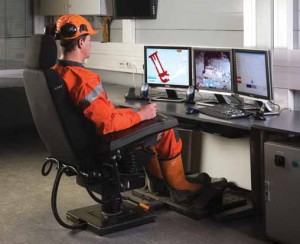This article from CNET shows the future of Mining in Minneosta. No we don’t need workers in Minnesota. We need game playing Nerds in far off countries digging up, moving, dumping and polluting Minnesota hundreds of times faster than at present. This appears to be a surprise to the author of this article. He apparently doesn’t know that this technology is currently being used and scaled up for use anywhere in the world. Can you say REMOTE MINING MINNSOTA???

More Mining – More Profits – Fewer and Fewer Workers
Dig this: I operated a giant excavator from 2,500km away
An Oculus Rift VR headset and a 4G network in Spain let CNET’s Roger Cheng control earth-moving heavy equipment in Sweden.
- by Roger Cheng
- March 5, 2015 10:09 AM PST
This was no simulation. Ericsson hooked up the seat and Oculus headset to a real Volvo excavator in Sweden, using a 4G wireless network for a real-time video connection. When I nudged the right control stick forward, the giant arm lifted up. It was a little freaky — and I loved it.
The excavator setup was one of the whiz-bang demonstrations Ericsson had in its traditionally massive booth, serving as an illustration of the power of cellular networks and its vision for a more connected world. It’s also a reminder that wireless networks can do more than just power our smartphones.
Ericsson came up with the idea in early 2011 after the disaster at the Fukushima Daiichi nuclear power plant in Japan. After watching volunteers risk their lives by operating heavy machinery inside the radiation zone, researchers started thinking about how to remotely control the equipment, according to Cristian Norlin, master researcher for the company.
Ericsson worked with Volvo to create a fully remote-controlled excavator.Sarah Tew/CNET”There’s got to be a better way,” he said.
Ericsson talked to fellow Swedish company Volvo, which was interested in the idea. The vehicle maker was dealing with a problem of its own: the lack of young workers willing to travel around the world to operate heavy machinery at a far-flung construction site. Volvo liked the idea of remotely controlling the equipment, and began working with Ericsson.
The company started with a toy excavator a year ago, but this year brought in two real excavators — one in Sweden and the other outside the halls of Mobile World Congress.
On the virtual reality side, Oculus Rift has been prominent among a new wave of devices designed to provide users with a fully immersive experience — pop on a VR headset, and the simulated 3D panorama could put you on a tropical beach even as snow falls outside your window, or insert you into the shoot-em-up action of a video game. As a startup, Oculus began its VR efforts several years ago, and, now owned by Facebook, it has been working with Samsung on a Gear VR device that the companies plan to have out to consumers by the end of 2015.
In the last year or so, the field has expanded greatly, drawing in technology giants including Sony andMicrosoft as well as HTC and game makers such as Valve. Virtual reality was the big theme at this week’s Game Developers Conference in San Francisco, an ocean and a continent away from where I was sitting.
The question remains, though, about whether virtual reality can blossom into a mainstream technology for everyday uses, or will burrow into niches here and there — such as industrial applications.
Driving the rig, remotely
My time in the operator seat was spent on the Eskilstuna excavator, a 6-ton Volvo EC55 concept model. With the Oculus Rift device strapped on, I swiveled my head around and looked up and down, surveying the dirt mound and empty plot of land around me. Ahead of me was the big digger bucket. The engine noise rumbled into my ears through surround-sound stereo headsets.
Volvo’s standard-issue EC55C excavator in action. The concept version had to be outfitted with remote controls.VolvoThe operator seat featured dual control sticks — one for each hand — and foot pedals. Given my ignorance of heavy machinery, Norlin acted as my guide, directing my hands to correctly control the excavator arm and to swivel the cab and arm. With a subtle move of my left hand, I turned the cab a few degrees to the right. With my right hand, I lowered the excavator arm and scooped up some dirt. I raised the arm, turned back to the original position and let fall the dirt.
The experience was brief, but it left a strong impression. I couldn’t stop thinking about the fact that everything that I was controlling was actually happening halfway across Europe.
I asked whether I could have really done some damage, and Norlin assured me that the excavator was placed in an area far away from other people or buildings. So I then asked about the foot pedals and actually taking the vehicle for a spin. Norlin politely declined my request — something or other about liability.
The video feed was admittedly a little on the blurry side, occasionally struggling to catch up as I moved my head around. It was a real-time video stream that captured everything around me. There was also a slight lag between when I tapped the controls, and when the excavator responded.
Norlin said that the video feed and remote controls were pushing the network equipment to the limit, and that a fully polished version of this setup probably wouldn’t work until cellular networks move to the next generation of wireless technology, known as 5G, which will bring even higher speeds when it arrives as soon as 2020.
“We’re understanding what we can do with 5G,” he said.
As I stepped out of the operator seat, I couldn’t help but wonder about everything else we’ll be able to do with 5G. That, and the briefest consideration of a second career as a heavy machine operator.

Leave a Reply